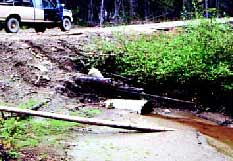| Forest Road Drainage Installation Practices | |
| in the Pacific Northwest | |
| 15 - Culvert Position | Channel Alterations, Depth, Slope, Frequency |
Crossing structures used at fish-bearing streams must not alter the stream channel unless the appropriate agencies approve the design. As a rule, open-bottom structures are required with footings and armour protection outside the wetted perimeter of the stream. Pipe culverts and closed-bottom arches can be used with approval of the agencies a long as fish passage is ensured.
Non fish-bearing stream channels should not be changed significantly to avoid destabilizing the channel. Maintain natural, stable debris in the channel above and below the crossing. If road construction has created a cut slope that may erode, armour the "cut slope stream channel". This will prevent sediment deposits at the culvert intake. Avoid sharp vertical or horizontal grade breaks, and allow water a direct and unobstructed entry into culverts. Use catch basins as required.

Ensure that culverts are not placed too low to allow sufficient slope for water to drain away. This happens frequently in flat terrain when ditches are excavated too deep. Use overlanding road construction techniques to keep the road elevated above the water table. Improper drainage may also result from culverts settling in soft ground. If this is recognized during the installation as a potential problem, place proper foundations under the drainage structure, i.e., shot rock, or support log culvert with three or more mud sills (logs placed under the bottom crib logs parallel with the road). Always use sufficient fill and raise grade slightly above culverts to avoid low spots and water accumulations which introduce sediment to streams from vehicle traffic.
Culverts in fish streams must follow the natural slope. All other culverts should always have a minimum slope of 2% to allow water to drain, and to prevent the deposition of materials inside the culvert. Do not exceed slopes of over 20% for culvert installations unless designed and approved by professionals. It is difficult to install culverts with steeper gradients than that, and doing so may create instability. Increased velocities at the culvert outlet can cause fill or channel erosion, and may cause vibration of the structure during high flows which in turn contributes to piping failures.
Instead of installing cross drains at measured intervals, place them frequently enough that small pipes (400 - 500mm or 16 - 20in) will easily handle peak flows. Install them with good ditch blocks at junctions, low spots, above and below switchbacks, and at known seepage sites. Do not use ditches to move seepage water and surface runoff over long distances of 15m or more (50ft), especially on steeper grades or in finer materials. Rolling grades or depressions (swales) help to drain surface runoff and act as failsafe backup for cross drains. Always consider consequences of plugged drains and plan for a backup.
| 15 - Culvert Position |
| Next |
||
| PLANNING ISSUES |
INSTALLATION PRACTICES
|
|
©1999 - 2001 Flip Productions Limited Used with permission by CulvertBC |